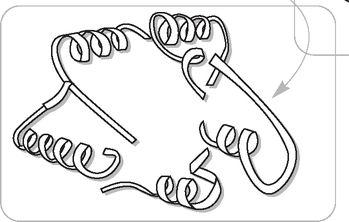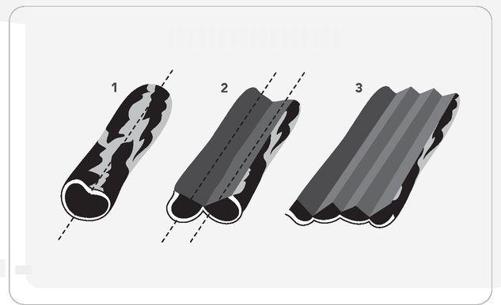I'm Just Here for the Food (35 page)
Read I'm Just Here for the Food Online
Authors: Alton Brown
Tags: #General, #Courses & Dishes, #Cooking, #Cookery

That is, until they meet the salt. Then they look sort of like this:

This is what denatured proteins look like. Notice that they’ve gone from tight little separate springy things to big loose coils that have managed to get all tangled up with each other. During the cooking process, this tangled-up structure traps water almost like a gel, which means two things:
1. Brined meats are juicier when cooked.
2. Since they hold more moisture, brined meats are more forgiving of overcooking.
For instance, a turkey cooked to 165° F will taste okay and will be relatively moist, but it dries out quickly with every degree over.
A brined turkey, on the other hand, can reach all the way to 180° F without losing its finger-lickin’ status. This rule applies equally to all pork cuts, all poultry and fowl, and, oddly enough, shrimp.
Orange Brine
This brine is equally good on all kinds of poultry and pork—and I like it best on pork loin or even pork chops. It’s good for grilled pork tenderloin, too, but you might also consider basting the tenderloin on the grill with a combination of orange-juice concentrate mixed with the hot sauce of your choice.
Application: Brining
In a pot bring 2 cups of the stock, the salt, brown sugar, peppercorns, and bay leaves just to a boil. Stir to dissolve the sugar and salt. Add the remaining stock, the orange juice, and 2 quarts ice water, and pour into a 2-gallon bucket. When the mixture has cooled to below 40° F, add the meat in a cool place (to maintain a sub-40° temperature). Let it brine for at least 8 hours and up to 48. Remove the meat from the brine, pat dry with paper towels, and cook as desired.
Software:
1 quart vegetable stock, chilled
½ cup kosher salt
¼ cup dark brown sugar
1 teaspoon black peppercorns
2 bay leaves
1 quart orange juice, chilled
2 quarts ice water
Hardware:
Medium stock pot
2-gallon plastic bucket
Thermometer
Paper towels
A Dip For Mr. Dennis
Mr. Dennis is an old New England euphemism for the family pig. This brine is excellent for pork, especially chops, which can soak for as little as ½ hour to nice effect.
Application: Brining
Combine spices in a tea ball or tie them securely into a paper coffee filter and place in pot with salt and molasses. Add water and bring to a boil. Remove from heat and cool to room temperature. Remove the tea ball and discard the spices; pour the liquid into the bucket and add the meat. Allow the meat to brine for at least 6 hours or as long as 12 hours. Remove the meat from the brine, pat dry, and immediately cook as desired.
Software:
1 tablespoon juniper berries
1 tablespoon whole black
peppercorns
10 whole cloves
1½ cups kosher salt
½ cup molasses
2 quarts water
Target cut of pork
Hardware:
Tea ball or paper coffee filter
and string
Medium stock pot
2-gallon plastic bucket
Shrimp Soak
Brining improves both the flavor and especially the texture of shrimp—after a soak, these crustaceans are completely plumped up with moisture. I recommend broiling them right in their shells on a sheet pan.
Application: Brining
Bring 1 cup of water to a boil in a small sauce pan. Add the salt and sugar and stir until the crystals have dissolved.
Pour the mixture into the plastic bucket and add the ice. When the ice has melted, add the shrimp and allow to soak—½ hour for 21/55s, or up to 1 hour for the really huge shrimp that some people erroneously call “jumbo.”
That’s 21 to 25 shrimp per pound
Remove the shrimp from the brine, pat dry, and cook immediately.
Software:
1 cup water
¼ cup kosher salt
¼ cup sugar
1 pound ice
1 pound shrimp, unshelled
Hardware:
Small sauce pan
1-gallon plastic bucket
Grilled Mahi-Mahi, Ceviche-Style
This mahi-mahi is a winner. It retains a super fresh-fish flavor and the sauce is tangy and spicy with a clean finish from the herbs.
Application: Marinating, Grilling, and a Sauce
Rub the filets with kosher salt and set aside. In a non-reactive bowl, combine the remaining ingredients except ¼ cup of the cilantro and the olive oil. Mix to dissolve the sugar, and add the filets to the bowl. Marinate for 2 hours, turning the filets once after 1 hour. Remove the filets from the marinade and set it aside. Pat the filets dry with paper towels and lightly coat with the olive oil.
Heat the charcoal and grill the filets over direct heat until they are just cooked through—opaque at the center but still moist. While the fish is grilling, add the reserved marinade to a saucepan and heat until it is reduced to about ⅓ cup. Using tongs, remove the filets to serving plates and divide sauce equally among them. Top with remaining cilantro.
Yield: 4 entrée servings
Software:
4½ pounds skinless mahi-mahi
filets
1 teaspoon kosher salt
½ cup diced red onion
¼ cup freshly-squeezed lime juice
¼ cup freshly-squeezed orange juice
1 tablespoon minced jalapeño
pepper
½ cup chopped cilantro
¼ cup dark brown sugar, packed
¼ cup tequila
1 tablespoon olive oil
Hardware:
Non-reactive bowl
Charcoal
Charcoal starter
Long tongs
Saucepan
Marinated Vegetable Salad
Application: Marinating
Cut each vegetable into uniform pieces: trim the ends of the beans; trim the bottoms off the asparagus; floret the broccoli and cauliflower; cut the carrots into rounds; and peel the beet and cut it into wide matchsticks. One kind of vegetable at a time, drop them into a large pot of salted boiling water and blanch until crisp-tender. Pull a piece out every few seconds and check it. The broccoli should only take about 45 seconds, but the cauliflower might take more than a minute. Do the carrots next to last as they’ll discolor the water, and finish with the beets. Do not blanch the onion.
As each vegetable is ready, remove them to an ice-water bath to stop them from cooking. This is very important; if you don’t have an ice-water bath ready, the vegetables will continue cooking after you pull them out of the water and they’ll get too soft.
Thoroughly drain, then put all the vegetables—except the broccoli and the onion—in an airtight plastic container and lightly season with salt and pepper.
In a mixing bowl, blend the tangerine, lemon, and lime juices. Add the vinegar, garlic, shallot, and mustard. Whisking constantly, add the oil in a thin stream to emulsify. Add the tarragon and pour over the vegetables in the container. They should not be drowning in the marinade. Refrigerate for several hours or overnight, turning the container periodically.
When ready to serve, add the broccoli and onions to the party. If you add them earlier, the onions will “bleed” pink on all the vegetables and the broccoli will turn gray from the acidity.
Yield: 1 huge platter of vegetables
Note:
If you can’t find tangerines consider using grapefruit; oranges aren’t acidic enough to fully marinate the vegetables.
Software:
½ pound wax beans or green beans
1 bunch thin asparagus
2 broccoli crowns
1 head cauliflower
3 large carrots
1 golden beet about the size
of a baseball
1 medium red onion, sliced
Lyonnaise-style
Kosher salt
Freshly ground black pepper
Juice of 4 tangerines (¾ cup;
see
Note
)
Juice of 1 lemon (2 tablespoons)
Juice of 2 limes (2 tablespoons)
¼ cup champagne vinegar
1 tablespoon chopped garlic
1 tablespoon chopped shallot
1 teaspoon Dijon mustard
¼ cup good olive oil
2 tablespoons chopped tarragon
Hardware :
Paring knife
Large pot
Spider or slotted spoon
Large ice-water bath
Large lidded airtight plastic
container
Mixing bowl
Whisk
Olive-Stuffed Pork Loin
Application: Brining and Roasting
Brine the pork.
Stir the sugars, salt, peppercorns and cider vinegar in a 4-quart saucepan over medium heat until everything is dissolved. Remove from the heat and add the ice. Stir until the ice has melted and the brine has cooled. Submerge the tenderloin in the brine and stash in the chill chest for 2 hours.
Make the stuffing.
Take the olives and olive oil for a spin around ye ole food processor until a semi-uniform paste is formed.
Preheat the oven to 375°F.
Stuff the pork.
Cut the tenderloin lengthwise down the center, but do not cut all the way through the meat; leave about ⅛ inch connected. Make two more incisions on each side of the center cut; again leaving ⅛ inch. Spread the olive paste into each groove and tie the loin with the butcher’s twine to bring it back to its original shape. Place the tenderloin onto the rack set in the half sheet pan lined with parchment paper. Set on the center rack of the oven and roast for 25 to 30 minutes or until the meat reaches an internal temperature of 145°F. Remove and rest at room temp for 10 minutes before slicing.
Yield: 4 servings
Software :
1- to 2-pound pork tenderloin,
trimmed of exterior fat,
connective tissue and the like.
For the brine:
1 cup dark brown sugar
1 cup sugar
1 cup salt
1 tablespoon black peppercorns
2 cups apple cider vinegar
1 pound ice cubes
Forthe stuffing :
½ cup green olives, pitted
½ cup kalamata olives, pitted
2 tablespoons olive oil
Hardware :
Cutting board
Chef’s knife
4-quart saucepan
Food processor
Butcher’s twine
Half sheet pan
Rack for half sheet pan
Parchment
Meat thermometer
CUTTING DIAGRAM
